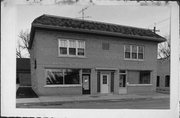| Additional Information: | The Baldwin Estate Building was building in 1945 and was first occupied by the George Seidel Apothecary, and important twentieth century drugstore in Sparta. The George Seidel Apothecary previously opened around 1916 in the Masonic Temple Building at 100 North Water Street. Seidel's pharmacy was located in the Masonic Temple building probably until 1945, when Seidel moved his pharmacy headquarters to the Baldwin Estate Building at 110 East Franklin.
This piece of land was first owned by the J.H. Baldwin family in 1876. According to the tax records, it remained in the Baldwin family at least until 1930 or later.
There were at least two earlier buildings on this property. The first building was a small structure associated with the Ida House. It was listed as sampling room (1889) for the Ida House, which was directly across the street on the southeast corner of East Franklin and North Water Streets.
The second building on this property was a gun shop owned by the Baldwin family, which was at this address as early as 1875.
By 1900, both buildings were incorporated together, which became J.H. Baldwin's Gun Shop and Bicycle Shop. This gun and bicycle shop lasted until circa 1922, when the building was used for an electrical supply store.
Though the Baldwin Estate Building is of recent construction (1945), it gains local significance under Criterion A in association with the topic Patent Medicine and Drug Industry of the Industry Theme and Criterion B in association with the building's relationship to the J.H. Baldwin Family. This building should fall into the exception criteria for properties constructed during the 50 year non-historic period for several reasons. The Baldwin Estate Building was the home of George Seidel's Apothecary, an important twentieth century Sparta drugstore, an dthe building itself was erected by the J.H. Baldwin family. The Baldwin family occupied this particular location as early as 1875 and as late as 1922 with a gun and later a gun/bicycle shop.
Constructed of rust-cream colored brick, this two-story combination retail and office building is characterized mainly by an overhanging mansard roof [roof is flat at the rear of the building] and is minimally ornamented by a decorative belt course of brick above the upper story windows and above the windows in the lower story of the west elevation. Rectangular windows arranged in two groups of three with vertically divided lights i the upper sash and long rectangular windows with concrete sills further characterize the facade. Single windows are displayed on the west elevation. An entrance featuring a sidelighted door and a cornice resting on corbeled brackets above the door is located in the center of the lower facade. This central entrance is flanked by two doors topped by transom windows that lead to two commercial spaces on the lower story [presently, east door replaced with window].
This commercial building has been altered by the addition of replacement metal storm windows on the upper story, by the replacement windows on the lower story, and by the alteration of the entrance door to the east commercial space.
Designed by La Crosse architect Frank Fuchs, this building was built as a combination retail and residential building [apartments on the second floor] for the William Baldwin Estate in 1944. Constructed by Peter Nelson and Son Construction Co. of La Crosse, this building was originally used to house the Seidel Drug Store. This brick building replaced the frame and brick building previously on the side known as the J.H. Bladwin Gun Shop and Bicycle Shop, which was established on the site in the 1880s. The old Baldwin building was torn down after the gun shop equipment was sold in 1944.
The Baldwin Estate Building does not meet the the NRHP criteria for architectural significance because it is of modern-contemporary design and less than 50 years of age. As a result, this building does not contribute to the historic character of the proposed Water Street Historic District. |
|---|
| Bibliographic References: | (A) City of Sparta, WI, Community Development Office, Building Permit File.
(B) City of Sparta, WI, Tax Records, 1870-1945.
(C) Sparta Herald 6/5/1944; 6/26/1944.
(D) Middleman, Julia, interview, Sparta, WI, 6/6/1990.
(E) Sanborn Insurance Map 1884, 1889, 1894, 1900, 1911, 1922, 1931.
(F) City of Sparta Property Tax Rolls, 1870-1940.
(G) French, Bella, "History of Sparta, Wisconsin." The American Sketchbook. La Crosse: Sketch Book Company, Publishers, 1875, p. 70-74.
(H) City Directory of the City of Sparta, Wisconsin. Sparta: compiled and published by E.B. Bell, 1916. |
|---|

